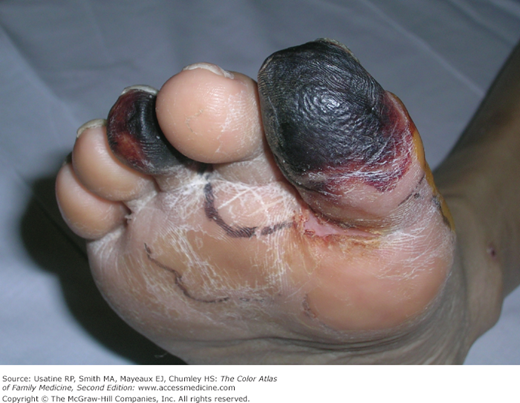Patient Story
A 36-year-old woman with type 1 diabetes presented with a 4-week history of a dry, black great toe and third toe on the right foot (Figure 213-1). She said that she noticed severe maceration between the first and second interspace approximately 6 weeks ago. Subsequently, the toes changed color and became very painful. Two days ago, she noticed a foul odor from both toes. The patient reported smoking since she was 13 years old. On physical examination, there were no palpable pulses in the right foot. The patient was admitted for IV antibiotics and revascularization was performed. Subsequently, the toes were partially amputated and the wounds healed without any complications. Her physicians attempted to help her to quit smoking without success.
Introduction
Dry gangrene develops following arterial obstruction and appears as dark brown/black dry tissue. Peripheral arterial disease is common in patients with diabetes and dry gangrene is most commonly seen on the toes. The nonviable tissue becomes black in color from the iron sulfide released by the hemoglobin in the lysed red blood cells.
Epidemiology
Etiology and Pathophysiology
- PAD manifests in the lower extremity in two ways: macro- and microvascular diseases.
- The pattern of occlusion in the macrovascular tree is distal and multisegmental.2
- Multiple occlusions occur below the trifurcation of the popliteal artery into the anterior tibial artery, posterior tibial artery, and peroneal artery.
- Risk factors, such as hypercholesteremia, hyperlipidemia, and hypertension, are often associated with patients with PAD and, therefore, poor wound healing.3,4




